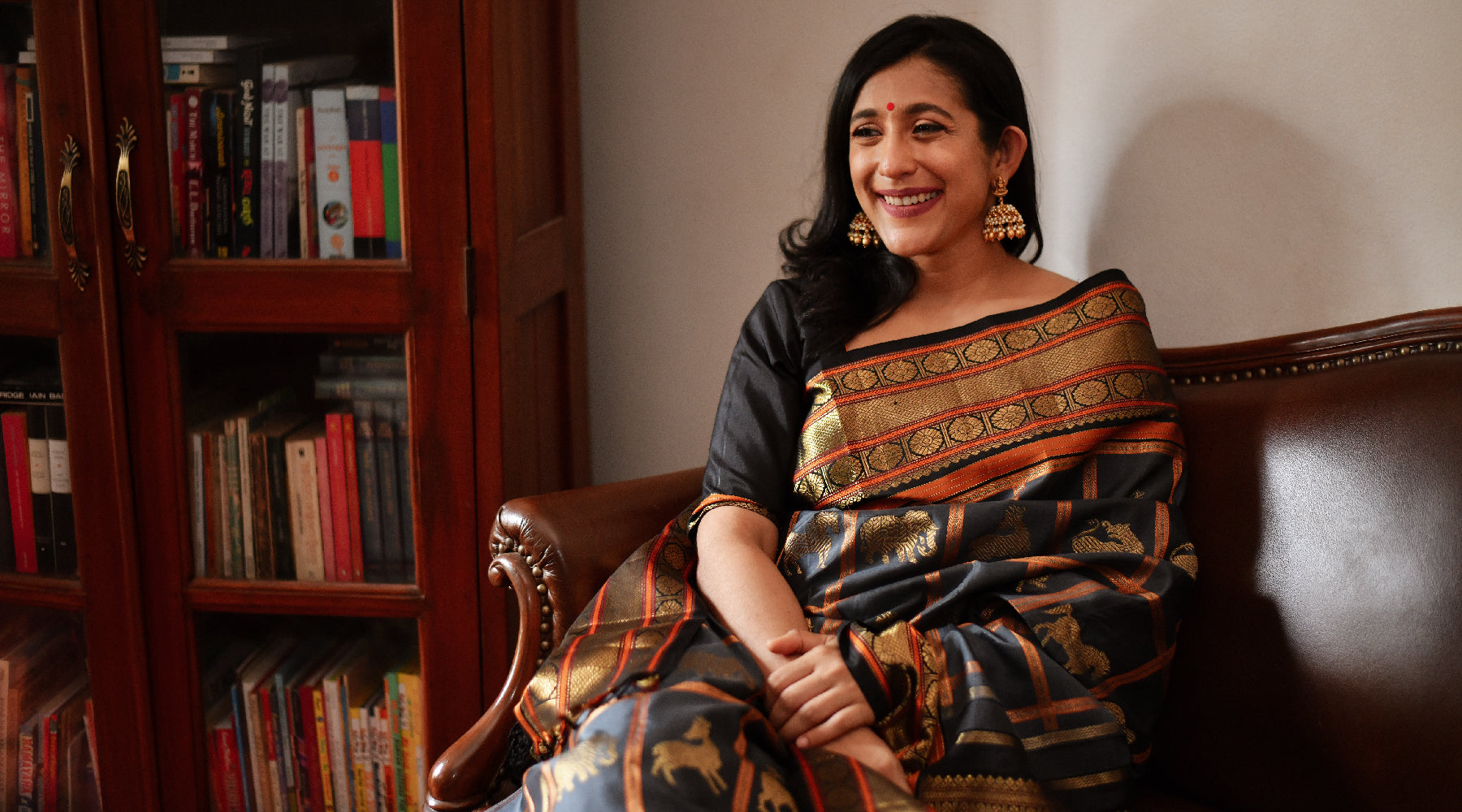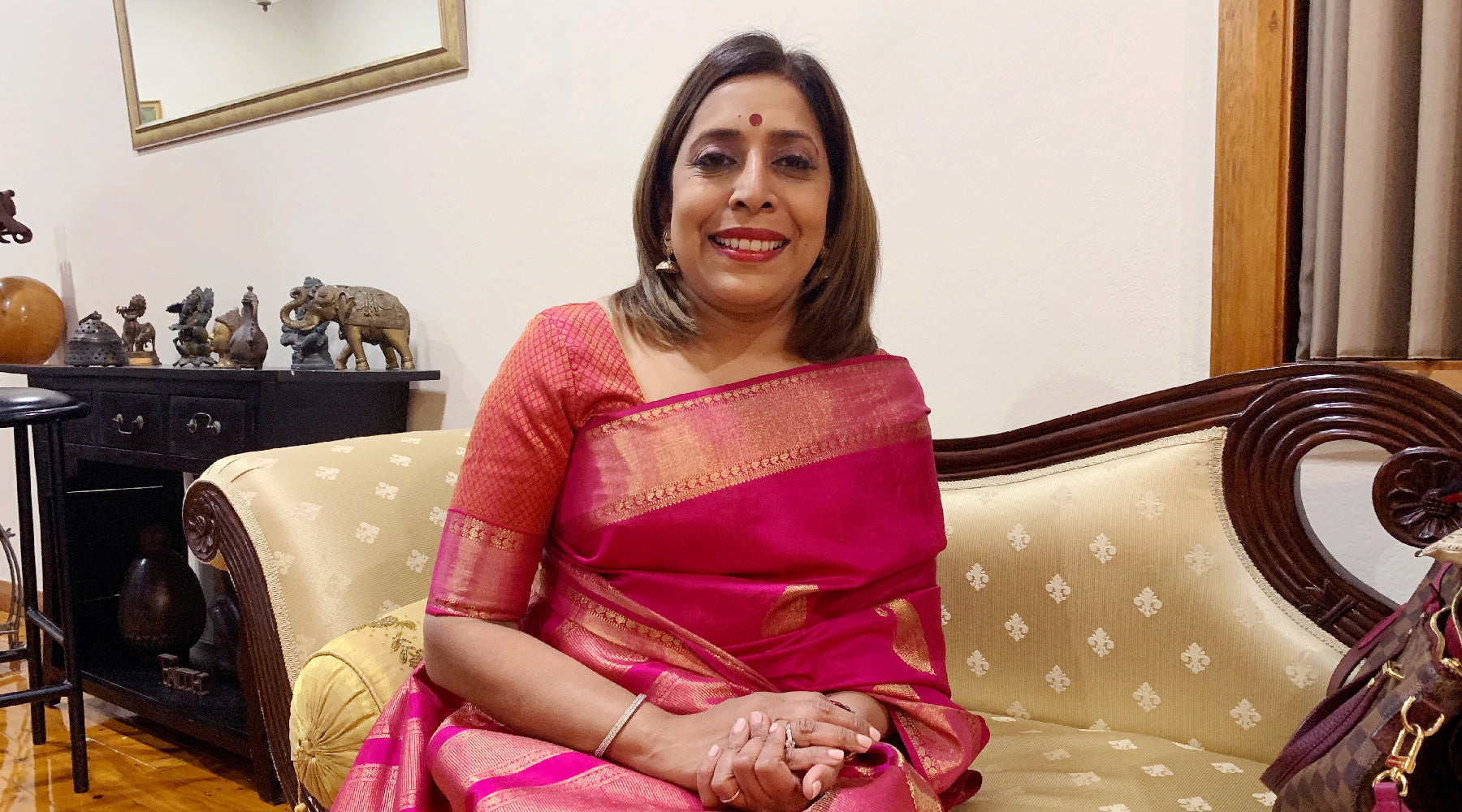KANAKAVALLI VIGNETTES : Anita Ranjani - In Search Of Integrity

Despite resisting Bharatanatyam dance classes as a little girl, Anita Ranjani, Kanakavalli’s August Vignette, now spends almost all of her time dancing, teaching, learning, and passing on the traditions of this classical art form that she has grown to love. In conversation with Aneesha Bangera of the Kanakavalli Journal, Anita opens up about her evolving relationships with her mother, with her brother and with dance itself, as well as about her attempts to explore her North and South Indian heritage through dance. She shares her hopes and fears for the future of the Indian classical performing arts in the US, expressing the belief that integrity and context around authenticity are the only way forward. Candid and articulate, warm and funny, Anita takes a moment out of a busy schedule to browse through the Kanakavalli repertoire, curating a selection of fine kanjivarams that speak to her sense of beauty and tradition.
In Search of Integrity
Tell us a little bit about what is was like growing up in the US as a child of Indian origin. What were the ways in which you and your family sustained your connections to your Indian roots?
I had a very normal childhood. I didn’t ever feel like an outsider and I fit in just as easily with my American friends as I did with my Indian ones. My mother was a single parent, and ours was a very middle-class home. My mother, who is South Indian, is very passionate about the classical arts. So as a child I attended a lot of kutcheris by renowned artists, and I now know that I was in the presence of greatness without ever realising it. I remember that many of my Indian friends would go to India every year, but I never went as often. The first time I recall going to India I was in the 6th grade, and I was so excited because I had heard so many stories. When I got there, I fell really sick, and it was not really what I had expected. I think I had been very in touch with Indian culture, but the reality of living in India was very different. The next time I went back to India was as a teenager to shop for costumes and jewellery for my arangetram, and I really enjoyed that experience. In a way, that was a turning point for me to start loving my visits to India. I then went back more often to continue my dance training, and I started feeling a sense of purpose for being there.
Why was it important to your mother that you learnt Indian classical dance? What was your relationship with your mum like when you were young, and has this relationship evolved?
My mother always wanted to be a dancer but her father never allowed her to pursue her passion. She had learnt and taught dance, but had to do it all in secret, without her father’s knowledge (until she was much older). When she had a daughter of her own, it was very important for her to pass on her love for the arts. So, I was very much living my mother’s dream. In fact, when I first starting training in dance I did not at all enjoy it, something that changed completely later. If I had to pick one word to describe my mother, it would have to be rockstar. She is a superwoman. I’m sure everyone feels this way about their mom, but everyone who knows my mother knows that she really is incredible. The level of energy she has, the amazing things she does for the community… she is one hundred percent my hero. She is a single mother, but I think she has given me things that even people with two parents might never have had. When I was young, she was strict – I had rules, a curfew and chores to do around the house. At that time, she wasn’t necessarily a friend to me; she was very much the parent, but was very loving and affectionate. As I grew up though, my mother became my best friend. Even now, I call her multiple times a day. She’s the first person I call with good or bad news, and she is always there for me. My mother also has a lot of trust in me. This used to irritate me when I was younger–she would say she never worried about me getting in trouble, because I would tell her before I even got into it! I could never keep a secret from her, and I still can’t.

Above (from left): Anita as a baby in her mother's arms; Anita's mother in a black and red sari, similar to the palette of Anita's Vignettes kanjivaram; With her mother again
Could you tell us a little bit about the things that bring you and your older brother together?
My brother and I are almost 17 years apart in age. He moved across the country to California when I was just six years old. I worshipped him absolutely and I was so upset when he left. I remember he would fly across the country to Philadelphia for my birthday every single year, even if it was just to spend a few hours with me. He was like a father to me, and he wore both hats very well – the fun hat and the strict hat. When I was young and my mother was out or at work, my brother would babysit me. Often, he would sit me on his lap and watch football games, under the misguided notion that I enjoyed the sport, when all I wanted to do was play! But over the years I started loving football too. Now, football is something we bond over, and I was able to take him to the Super Bowl game where the Philadelphia Eagles won for the first time in 52 years of NFL history! That was the first time just the two of us hung out, as adults. My brother now has three kids of his own, and his eldest is about to go off to college. But I still worship him, and he has a special place in his heart for me.

Above (from left): Roughhousing with her brother who is 17 years older than her; Anita as a child with her brother; Anita and her brother at the Super Bowl when the Philadelphia Eagles won for the first time in NFL history; With her brother who she has always worshipped
You have talked about your mixed heritage - half South Indian and half North Indian. How do you explore and define this aspect of your identity?
My father was North Indian, but he was never a part of my life growing up. I never had any kind of connection to the culture, I didn’t know the language, and I didn’t even really know which part of North India (Shahjahanpur) he was from until he passed away. This part of my heritage has always been a very big question mark in my life. My mother has shown me so much of the South Indian culture, so I decided to start studying Kathak to explore the part of my heritage that was unfamiliar to me. My mother and gurus at first wanted me to focus only on Bharatanatyam, but for me Kathak isn’t just about being a Kathaka on stage, but about understanding the culture and where it comes from. The thing I love about studying the classical arts is how vast they are. Even if you study every moment of everyday for the rest of your life, you’ll never know everything you can know. I love the fact that it is an oral traditional. Interacting with somebody to learn an art is a very beautiful process. I currently practice both Bharatanatyam and Kathak, and I’m learning to balance. But there is a difference, because I’ve known Bharatanatyam for nearly 30 years and it’s an essential part of me; it’s in my blood. With Kathak, I am not at the same stage, but the practice and continuous discovery romances me. I’m at two different places in the process with each form, but equally dedicated to both. Each form has its own sense of beauty that I love and appreciate, and gives me a chance to explore both elements of my identity.
As part of the Indian diaspora in the US, what do you see as the role of culture and the arts in fostering a sense of identity, belonging and community?
To be very candid and honest, I’m actually a little scared of how the arts are being carried forward right now. I feel like Indian things are a big fad in the US at the moment. It wasn’t like this when I was growing up, but now Indian art, culture, food and fashion are so popular that they are being diluted. Because the field is just so saturated, someone who doesn’t have the right connection to Indian culture might not be able to identify what is truly authentic. That’s not to say that everything must always be authentic, but there should be context so people can decipher what has come from tradition or how it may have evolved.

A big fan of the Philadelphia Eagles, Anita had kurtas made to show team spirit on game days when she had to be at dance practice. Here she is getting ready for Kathak class in her Eagles kurta!
From this perspective, one of the things about Kanakavalli that is so attractive to me is how the integrity of the kanjivaram is preserved in the way it is presented, in the experience of shopping for it, and how every sari has a story. I’m concerned that not all of the Indian art and culture being showcased in the US now has integrity behind it. I think every generation has a responsibility – my mother’s was to bring the arts to the West, while mine is to help uninitiated audiences learn what true classical tradition is.
My dance school, Naatya Seva, is a Conservatory for Indian Classical Performing Arts, the first of its kind in the US. It was a very deliberate decision to call it a conservatory. I believe that while the arts are always contemporary and always evolving, they are rooted in history, and conserving tradition is an integral part of the process. I am pioneering a festival this year which is significant to me on many levels. First, it is bringing the northern and southern art traditions together on the same platform. Second, it is focused on mainstreaming Indian classical performing arts, bringing them to stages and venues where one usually watches ballets and operas. I believe that we need to elevate the standard of what is being presented so that new audiences can see the integrity and richness of our performing arts; some of the finest gems our country has to offer. And finally, I wanted to establish this festival here in Philadelphia. I recently had legislation passed to annually celebrate September 6 as Indian Classical Performing Arts Day, as a way of recognising the value of our culture.

Vidya Vaibhavam 2019, a recital by the students of Anita's Naatya Seva Conservatory
When do you think your first discovered your love for dance? What are some of your favourite memories of dancing?
I actually vividly remember the first time I truly enjoyed dancing. Every year, I would spend time with my gurus, the Dhananjayans, at a workshop in the US. At the 1999 workshop I happened to be the only student from my dance class attending, and just out of sheer experience, I happened to be one of the senior-most attendees. By this time, my gurus trusted me, and made me take on some of the roles of an assistant teacher. The combination of dancing consistently every single day with being in a position of leadership made me see things a little differently. Until this point I had danced because my mother forced me. I had put in very little effort or practice, and had shown almost no interest. But this experience gave me the confidence I needed to know that I could be a better dancer. The fact that someone saw potential in me and pushed me was really the turning point for me. The other thing I absolutely began to love about dancing was the sisterhood of being with all my dance friends. We worked very hard together in the classroom under our Guru Shoba Sharma, but we also had so much fun. After class, we would have slumber parties and movie nights. We all went on to become dance teachers ourselves, dancing in Shoba Akka’s repertory company.

Above (from left): Anita with her guru before her first performance in Chennai, at the Mylapore Fine Arts Club; With her teacher Shoba Sharma during her first photo shoot for the Pennsylvania Council on the Arts
We are scattered across the world now, but are still there for each other. One thing I vividly remember is that as a child I was always incredibly excited about our final performance, even though I didn’t even enjoy dancing at that age. And the reason I looked forward to this all year is that it was the one occasion I could wear lipstick! Funnily enough, I went on to pursue a corporate career in cosmetics, and lipstick is probably one of the things I care least about now, having had exposure to the finer details of the craft and all the other fun products!
Living in the West, does your exposure to the Western media and culture influence your practice and performance in any way?
At a very superficial level, one of the things that Indian arts have a lot to learn about from the West, is how to package and brand themselves. One of the biggest disconnects we face is that our arts are so rich, but are not presented in an approachable or dignified manner to get the exposure they need. Many western companies, for example, do a fabulous job of organising themselves around seasons and presenting their shows. My observation, specifically in the way south Indian arts are presented around the country, is that the emphasis is on the quantity of shows presented. It’s designed as a way for the community to keep in touch with the arts with the hope of reaching a wider audience. It’s now time to find a balance and have the same emphasis on the quality of presentation to ensure that we are telling the story in the right way to reach a wider audience.
What do beauty and tradition mean to you?
I think beauty means something different to everybody, and that’s why, for example, we don’t just have one kanjivaram design. It is why there are endless possibilities for colour, pattern and weave. Beauty is so subjective and I think this is a wonderful thing. Tradition is very important to me. I think everyone has to be comfortable with evolution, because ultimately, we’re all evolving all the time. But tradition is where you come from. It’s important not only to respect the tradition you came from, but also to share it with those who don’t know it and pass it on to future generations. Tradition, after all, is history. I believe Kanakavalli is the epitome of tradition. For me and those of my generation, we look to the saris that our mothers, grandmothers and fashion icons like Leela Samson wear. Unfortunately, I haven’t seen a curated selection of saris as beautiful anywhere except in Kanakavalli’s beautiful collections. I love that every Kanakavalli sari has a story, and I think it’s the experience of shopping at the stores that makes you feel closer to the tradition of the kanjivaram.

What is the role of the sari - and the kanjivaram in particular - in your life?
A sari is something that will always put me in a good mood; it instantly shifts how I carry myself and walk into a room. It is so flattering to everyone, and it can be draped in so many ways–the creative possibilities are endless! I think the sari speaks to the history and traditions of our country. Every time I wear a kanjivaram, I still get that feeling of being a little girl watching my mother wear the most amazing saris and how regal it made her look. As a dancer, the sari is important as a costume. What’s interesting is that there can be a big difference in picking saris for the stage—they might not be the ones you choose for a normal occasion, because you’re searching for something that represents your character or thematic elements of the piece. It is a very fun and very personal process that I enjoy. Tell us the story behind the Kanakavalli sari you chose to wear for the Vignettes shoot. My mother has a reputation for always wearing only black or cream saris. I guess that’s why I also always gravitate towards similar colours. You will almost always find me wearing black or bottle green. Funnily enough, while looking through old photographs for the Vignettes piece, I found an old photo of my mother wearing a black sari with a red border, very similar to this one I’m wearing. I suppose we have very similar taste!

Anita is wearing a gorgeous Kanakavalli kanjivaram in black dotted with geometric buttis in gold. Elephants and mythical animals adorn the border amid bands and stripes in red and off white. The pallu is woven in 'adai' and features horse, parrot and paisley motifs in fine gold zari.
- Anita Ranjani, in conversation with Aneesha Bangera, photography by Raghuram Vedant
View Anita's guest curation here



